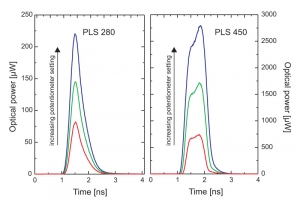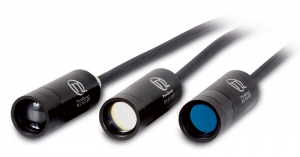Picosecond Pulsed Sources
PLS Series
Sub-nanosecond Pulsed LEDs
- Wavelengths from 255 to 600 nm
- Peak power up to 2.5 mW
- Pulse widths as short as 600 ps (FWHM)
- Repetition rate from single shot up to 40 MHz
- Optional bandpass filter
 The pulsed LEDs of the PLS Series are the fastest miniature sub-nanosecond pulsed LED sources commercially available. They combine short pulse widths with high repetition rates in a compact and maintenance free set-up.
The pulsed LEDs of the PLS Series are the fastest miniature sub-nanosecond pulsed LED sources commercially available. They combine short pulse widths with high repetition rates in a compact and maintenance free set-up.
Direct emission in the ultraviolet
The LEDs of the PLS Series are the only available compact pulsed light sources that emit directly in the ultraviolet spectral range at wavelengths as short as 255 nm. Eight different LEDs with central wavelengths between 255 nm and 370 nm allow to choose a peak wavelength according to the needs of the application. Their spectral and timing characteristics are also particularly suitable for biomedical applications, e.g., for the detection of labeled substances as well as naturally fluorescent amino acids like tryptophan or tyrosine.
Pulse widths down to 600 ps
All pulsed LEDs emit picosecond pulses with a full width at half maximum (FWHM) of less than one nanosecond – at some wavelengths even pulse widths down to 600 ps are possible. The pulse width itself cannot be controlled, but does depend on the selected power level of the LED.
Average power of several microwatts
 All LED heads are designed to emit an about constant pulse energy at a given intensity setting. Doubling the repetition rate therefore effectively doubles the average output power. The achievable pulse energies of the LEDs in the visible spectrum can reach up to 2 pJ, which corresponds to average output powers up to 80 µW at 40 MHz repetition rate. For the UV LEDs the achievable pulse energy is lower and typically below 1 pJ. At their maximum repetition rate of 10 MHz, this corresponds to average output powers around 1 µW.
All LED heads are designed to emit an about constant pulse energy at a given intensity setting. Doubling the repetition rate therefore effectively doubles the average output power. The achievable pulse energies of the LEDs in the visible spectrum can reach up to 2 pJ, which corresponds to average output powers up to 80 µW at 40 MHz repetition rate. For the UV LEDs the achievable pulse energy is lower and typically below 1 pJ. At their maximum repetition rate of 10 MHz, this corresponds to average output powers around 1 µW.
Spectral width down to 10 nm
The spectral emission profile of all pulsed LEDs is broader than for pulsed diode lasers. For the UV LEDs the spectral width is smaller than 20 nm, whereas for the LEDs in the visible it may be as large as 50 nm. A further reduction of the spectral width is possible by using suited bandpass filters.
Suitable for time-resolved fluorescence spectrometers
The most important difference between the pulsed LEDs and pulsed diode lasers is the fact that the emission of the LEDs is divergent, not coherent, not polarized and also non-uniform in its intensity distribution. Depending on the LED used, different beam shapes can be seen ranging from near-round to elliptical. Fiber coupling into single mode or multimode optical fibers has therefore only very low efficiency – a notable exception are large area fibers such as liquid light guides. However, for short range interactions, e.g., in a compact time-resolved fluorescence lifetime spectrometer the LEDs of the PLS Series are very useful excitation sources.
All functions of the PLS Series LED heads such as repetition rate and output power are controlled and adjusted by the drivers Sepia PDL 810, PDL 800-D, or Sepia PDL 828.
(a) PLS with max. repetition rate of 10 MHz
| Average Power @ 10 MHz | ||||||
| Type | Wavelength (± 10) |
without filter | with colored glass filter | with bandpass filter4 | Spectral width | Pulse width (typical) |
| PLS 255 | 255 nm | --- | --- | 1 µW | < 20 nm | 800 ps |
| PLS 265 | 265 nm | --- | --- | 1 µW | < 20 nm | 700 ps |
| PLS 270 | 275 nm | --- | --- | 2 µW | < 20 nm | 650 ps |
| PLS 280¹ | 285 nm | --- | 1 µW | 2 µW | < 20 nm | 1300 ps |
| PLS 300¹ | 295 nm | --- | 1 µW | 2 µW | < 20 nm | 900 ps |
| PLS 575² | 575 nm | 3 µW | --- | --- | < 20 nm | < 1.3 ns |
Note: An internal security circuit prevents any damage if the these LEDs (PLS 255 to PLS 340 and PLS 575) are operated above 10 MHz.
(b) PLS with max. repetition rate of 40 MHz
| Average power @ 40 MHz | Spectral width (approx.) | ||||||
| Type | Wavelength (± 10) |
without filter | with bandpass filter4 | without filter | with bandpass filter4 | Pulse width (typical) | |
| PLS 370³ | 370 nm | --- | 10 µW | --- | 20 nm | 800 ps | |
| PLS 400² | 400 nm | 50 µW | --- | 20 nm | --- | 800 ps | |
| PLS 450 | 460 nm | 80 µW | 40 µW | 40 nm | 30 nm | 800 ps | |
| PLS 600 | 600 nm | 20 µW | 12 µW | 20 nm | 18 nm | 950 ps | |
¹ Supplied with a colored glass filter by default, a band-pass filter is available as an option for better performances.
² The emission is spectrally clean, no additional filter needed.
³ Always supplied with a bandpass filter.
4 Available as an option.
All PLS heads are supplied with an integrated lens.
| Dimensions | |
|---|---|
| Diameter | 30 mm |
| Length with collimator | 66 mm |
| Length with lens and filter | 80.5 mm |
All Information given here is reliable to our best knowledge. However, no responsibility is assumed for possible inaccuracies or omissions. Specifications and external appearances are subject to change without notice.
The sub-nanosecond pulsed LEDs of the PLS Series are ideal excitation sources in spectrometer systems that do not require high spatial resolutions. This includes applications such as:
- Time-Resolved Fluorescence
- Biochemical Analysis
- Detection of molecules labeled with Perylene, Coumarin, Fluorescein and Rhodamin dyes
- Intrinsic protein fluorescence from tryptophan or tyrosine
- Testing of optoelectronic devices such as pin-diodes and PMTs
The following documents are available for download:
Latest 10 publications referencing PLS Series
The following list is an extract of 10 recent publications from our bibliography that either bear reference or are releated to this product in some way. Do you miss your publication? If yes, we will be happy to include it in our bibliography. Please send an e-mail to info@picoquant.com containing the appropriate citation. Thank you very much in advance for your kind co-operation.




 Contact us
Contact us